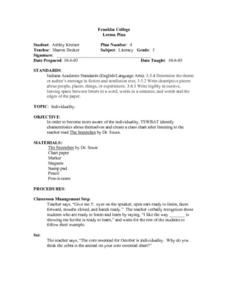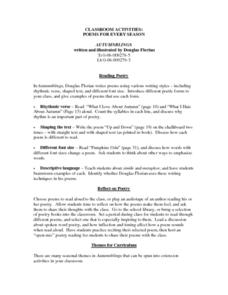Curated OER
The Catcher in the Rye: Found Poem Activity
After concluding The Catcher in the Rye class members create a found poem using words drawn from J.D. Salinger’s “Both Parties Concerned.” The story, and directions for crafting a found poem, are included with the resource.
Curated OER
Poe's Poetry and Prosody
Motivate your class with this lesson plan! Learners use passages from Edgar Allan Poe's poetry to practice reading fluency. They read "The Raven" as a rap song to better understand the rhyming patterns and pauses.
Curated OER
English Literature - PowerPoint PPT Presentation
Everything you wanted to know about the history of English literature and language but were afraid to ask. From Beowulf to Canterbury Tales, the Knights of the Round Table to Robin Hood, Addison, Fielding, Shakespeare, Swift, and many...
Curated OER
Figurative Language: Simile and Metaphor
What is figurative language? Introduce your young learners to the most popular forms of figurative language: the simile and the metaphor. Start by reading "Willow and Ginkgo" by Eve Merriam, and identify where similes are used. Then look...
Curated OER
Cinquain Syllables
Students identify and analyze various forms of poetry, then use information gathered from research to write their own cinquain poems. They then identify each syllable of their cinquain with a small icon that reflects the theme of their...
abcteach
Santa's Sack (Write a Poem)
What might Santa have in his sack? Young writers will answer this question in the form of poem inside Santa's sack. Next they will color the sack and draw a holiday scene.
Curated OER
Character Poems Self-Assessment
Use this worksheet to help your learners reflect on their work on a characterization assignment. They answer five questions about personality traits of the character of their choice as supported by the poem.
Curated OER
Poetry Pals
Students create the components for a slideshow featuring their own poetry, illustrations, and music. This lesson uses auditory, visual and kinesthetic (signing and clapping) learning styles.
Curated OER
Poetry--Homeless People
Eighth graders create a poem about homeless people using images they saw on websites. After reading the book "The Outsiders", 8th graders make connections of real life homeless people with characters in the book. Students search the web...
Curated OER
Write Acrostic Poetry
Third graders explore acrostic poetry and use names of their favorite personalities from television, music, or sports. They write descriptions for each letter of the person's name.
Curated OER
Colorful Creative Writing Rebus
Students read rebus samples from various sources. They write poems about colorful places, including detailed descriptions of people, scenery, and objects. Students create small, relevant illustrations to communicate meaning using symbols...
Curated OER
Let's Learn Library Language
This PowerPoint presentation provides a review of 'library language', vocabulary associated with books and the library such as cover, title, author, illustrator, call number and fiction/nonfiction. Each slide of this PowerPoint displays...
Curated OER
Senior English Beowulf Test
The first thirty-seven questions on this assessment check for knowledge of the events in Beowulf. The short answer prompt asks readers to identify five characteristics of an epic and to give examples from Beowulf in support. Finally,...
Curated OER
Poetry as a Fine Art
Sixth graders use a visit to the National Gallery of Art to inspire descriptive writing. They choose works of art and write descriptive word lists, paragraphs and Haiku.
Curated OER
Language Arts: What Makes an Individual
Third graders listen to the teacher read "The Sneetches" prior to creating charts about their individual characteristics. After numerous examples of individuality, they compile them on chart paper. As an extension, 3rd graders write...
Curated OER
Dali & Desnos: Surrealism in Poetry and Art
Students research the surrealism movement and its primary artists. Language is also analyzed, and students will create their own original poem utilizing surrealistic techniques.
Curated OER
Poetry: A Picture of Feelings
Students take a field trip to a place of interest. After the trip they share with a partner their most memorable memory about it. Later, they paint a picture representative of the trip and illustrate it with a poem using at least two...
Curated OER
Thanksgiving Acrostic Poems
Students watch streaming video, Holiday Facts and Fun: Thanksgiving, define and discuss acrostic poetry, complete circle map using words associated with Thanksgiving, and create acrostic Thanksgiving poems to be typed in Microsoft Word...
Curated OER
Poetry Prodigies
Students in three classes in different locations become Poetry Prodigies as they use iChat AV and an iSight camera to teach and explore from each other about different poetic styles. They explore six types of poetry are taught:...
Curated OER
Poems for Every Season
Students read and explore autumn poetry. In this poetry lesson plan, students read Autumnblings and are introduced to different poetic forms. Lesson includes ideas for exploring the poetic forms presented in the book and cross-curricular...
Curated OER
Christmas Tree Shaped Poems
Learners think about ways in which they can spread joy during the holiday season. They create poems in the shape of a Christmas tree. Pupils use formatting tools in Microsoft Word to format the text of the poem. Students discuss ways...
Curated OER
Interpretation of Poems
Students recite poetry and analyze its meaning. In this poetry interpretation instructional activity, students listen to a poem and work in groups to write what the poem is about. Students share and discuss the poem. Groups report...
Curated OER
Free Verse Poetry
In this language arts worksheet, learners will focus on free verse poetry. Students will articulate a free verse poem about family, feelings, and a favorite place.
Curated OER
New York State Testing Program English Language Arts Book 1--Grade 7 (2006)
In this New York State Testing Program English Language Arts worksheet, students read several passages and two poems and answer reading comprehension questions. Students then write an essay response to one of the passages.

























